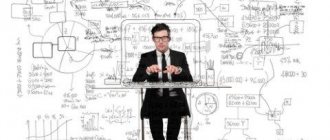Definition of a collective
From Latin collectivus is translated as “collective.” Therefore, we can say that a team is a certain group consisting of an N number of people united by common interests, ideas, tasks, and needs.
Any human activity requires participation in one community or another. Therefore, the concept of collective is defined not only by psychologists, but also by teachers. Opinions may differ somewhat, but the main essence is interpreted the same.
Concept in psychology
A group means a meeting, a crowd (gathering) of people, etc. For them to become a collective, there must be an organization present. If we “dig” deeper, then in psychology the definition of a collective is a community that carries out joint activities through interpersonal relationships, where the contribution of each individual is significant.
Teachers' opinion
Grouping of preschoolers, pupils, and students is classified as a group of pupils. Such communities are somewhat different from industrial ones. If a team in psychology is people united to jointly solve certain problems and perform specific functions, then in pedagogy the interpretation is slightly different.
Team of students
The co-presence of children in the group is an intermediate step that prepares for further activities. The goal of the workforce is to make a certain contribution to society. While the pedagogical group is engaged in the formation of an individual who should become useful to society.
Classification of groups
Lectures on management - Motivational management - Classification of teams
Based on the nature of internal connections, groups are distinguished between formal and informal.
Formal teams are created for external reasons: as a result of the organizational process, at the will of management, to perform certain tasks. They can be formed to perform a regular function (for example, a planning department) or to solve a specific target task (for example, a commission for the development of a project).
Formal teams are usually identified as structural units in an organization. They have a leader, a clearly defined structure of roles, positions and positions within the group, as well as formally assigned functions and tasks.
Formal teams ensure the unity of action of all components of the organization, the connection of various divisions with its common goals. Their identification is based on the expediency of the social division of labor.
In informal groups, relationships develop spontaneously. Their participants enter into regular interaction based on interests to achieve certain goals.
Informal groups are created not by management through orders and formal resolutions, but by members of the organization in accordance with their mutual sympathies, common interests, hobbies, habits, etc. Such groups exist in all organizations, although they are not represented in structural diagrams.
In informal groups, there are usually unwritten rules and norms of behavior. They develop a certain distribution of roles and positions. Typically these teams have an explicit or implicit leader. Often an informal team influences its member much more strongly than a formal structure.
In terms of composition , teams can be homogeneous (homogeneous) or heterogeneous (heterogeneous). These differences may relate to gender, age, profession, status, level of education, etc.
Diverse teams are more effective at solving complex problems; they are also effective during intense creative work (brainstorming). Homogeneous teams solve simple problems more effectively. The greater the similarity between team members, the greater their mutual influence, and the faster a sense of community is developed. However, in homogeneous teams, internal competition is more intense, and therefore they are more conflict-ridden.
An effective team must be made up of diverse individuals.
Based on recruitment methods, teams are distinguished between permanent and temporary.
Permanent teams (although individual members may come and go) give the organization stability. An example of such teams can be brigades, departments, small units located in the regular structure of the organization.
Temporary teams are created to work on a specific project or problem, for example, for the purpose of developing and implementing a strategy, restructuring an enterprise; to introduce new technologies. Upon completion of the tasks, they disband. Such groups often face problems :
- limited time to complete a task, so group members are likely to have “one eye” on the completion of the work, and with the other they are looking for the next task;
- different technical skills: less technically competent employees may be passive;
- the need for combination. In most cases, members of the temporary team are involved in the implementation of the project only part of the time;
- political and possibly personal interests. Team members may be there as representatives of a department or to perform a specific function rather than as professionals.
Based on the tasks performed, teams are divided into management groups, functional and production groups, and committees.
The management group (command group) consists of the head of the enterprise (division) and his direct subordinates, who, in turn, can also be managers (for example, the director of the enterprise and his deputies; the deputy director of the enterprise for production and the heads of departments and services directly subordinate to him and workshops).
A functional group unites the head and specialists of a functional unit (service, department, bureau, group), who implement a common management function and have similar professional goals and interests. For example, the quality department is interested in reducing the percentage of defects and accepting products from the first presentation.
The production includes a manager and workers who produce a certain type of parts (work). Members of the production team work together on the same task; the differences between them are related to the division of types of work depending on the qualifications of workers.
A committee is a group of an enterprise to which management delegates authority to carry out a project or task. Sometimes committees are called councils, commissions, task forces, or boards. They differ from other formal structures in their group decision making, which is sometimes the most effective means of achieving goals.
Based on the degree of work efficiency , teams are divided into working groups, pseudo-teams, potential, real and highly effective teams.
The working group relies on the overall result of the individual efforts of its members. Members of such groups interact primarily to exchange information and experience. There is no pressure for the formation of common goals or clear objectives for joint activities, therefore the interactions of group members are random in nature, because they are not supported by joint responsibility for the results obtained.
Pseudo -teams are groups whose members have not been able to take advantage of the benefits of joint activity, and have not made any effort to do so. They do not show interest in setting general goals or specific tasks, although the employees themselves or their managers may call such a group a team.
Members of potential teams feel the need for effective activity, and therefore strive to achieve high results in their work. For example, they realize the need for a single, clear goal (while it doesn’t exist, this negatively affects the team’s productivity) or have specific goals, but have failed to develop effective methods and methods of cooperation. On the path to high results, various obstacles arise, which cannot always be overcome.
True teams are small groups whose members have complementary skills and abilities, have common goals, objectives, and have developed effective methods of working together. They know how to meet the needs of the organization and the needs of group members; The team's capabilities exceed management's expectations.
Highly effective teams are groups that meet all the requirements for true teams and promote individual development of their members. The results they demonstrate exceed the expectations of others, and in some cases they can serve as a model for other teams.
Based on the degree of motivation to work, teams are divided into groups “X”, “Y” and “Z”.
Group "X" is not motivated to work. Its composition is usually heterogeneous in age, gender, nationality, and consists of low-skilled workers with a “soviet” psychology and a clearly expressed attitude towards minimal return and inactivity. Sometimes this may be an intellectual group that views work as a club where one can spend time in pleasant company, play computer games, have conversations, read literature, etc. The efficiency and effectiveness of such a group is low.
An authoritarian leader can motivate the work of members of group “X” by centralizing management functions in his own hands, using a directive style, clear planning and control, as well as severely punishing individual group members who do not complete tasks and violate labor discipline. Low-skilled executive members of such a group require training.
Group “X” cannot be entrusted with complex work that requires high quality workmanship.
Group “Y” is partially motivated to work. As a rule, such groups are created without taking into account the professional and gender-age structure, with the division of formal and informal leaders in microgroups, with a large proportion of people who do not have a level of knowledge and skills sufficient to complete the assigned tasks. In the “Y” groups there are many hardworking and efficient workers, but there are no clearly defined tasks and resource support; equalization in the wages of advanced and backward workers dominates. In a team, conflicts, intrigues and contradictions can often arise between individual microgroups and individuals.
To enhance the motivation of such a group, the leader must do the following:
- identify informal leaders and appoint them to the positions of foremen, foremen, and project managers;
- correctly determine target tasks and distribute management functions with partial delegation of authority to microgroup leaders or informal leaders;
- use a predominantly democratic type of governance;
- correctly use rewards for work results and punishment for failure to complete tasks;
- Constantly take care to maintain a good climate in the team.
Group “Z” is fully motivated to work, has a high level of qualifications and is relatively homogeneous in age, education, interests and motivation. Internal contradictions are easily overcome and the psychological climate in the team is very good. As a rule, the Z group consists of advanced workers motivated by self-affirmation and high levels of moral encouragement.
In group "Z" democratic or liberal leadership styles predominate. Therefore, the group leader can delegate part of his powers to microgroups; actively involve group members in the decision-making process, emphasizing collegiality rather than unity of command; actively apply rewards for achieved high results and quality of work.
What is meant by an ideal team?
Social perception - what is it in psychology
Any association of people is a certain atmosphere of relationships, it is influenced by the human factor. One can only dream of an ideal team. You can really get closer to the standard if you follow these principles:
- people united in a group must have a joint significant goal aimed at the benefit of society and not contradicting state norms;
- each team member participating in joint activities is interested in a positive result and bears responsibility on an equal basis with everyone else;
- the specificity of relationships in the team is visible not only in working cohesion, but also in moral cohesion;
- one of the principles of the team is democracy; management bodies are an authority for subordinates, and at the same time, managers respect those who stand on the lower steps of the hierarchy, listening to their opinions.
Additional Information. Ideally, a team is highly organized, where such characteristics as mutual understanding, “a sense of community,” selfless relationships, and goodwill are manifested.
In a friendly team, there is a completely different attitude towards work and responsibilities. Members of an ideal community are able to intelligently combine public and personal interests without compromising production and family.
The team as the highest form of group development
The team in which the individual develops and is educated is the connecting link between him and society.
A team is a group where interpersonal relationships are mediated by the socially valuable and personally significant content of joint activities. This is its main psychological difference from other groups. Not only the predominance of manifestations of collectivist self-determination of conformal reactions, but also a number of other psychological phenomena.
The first psychological phenomenon of the team, which was discovered during the study of interpersonal relationships in the team, was
collectivist self-determination. Experimentally, collectivist self-determination was identified in the study of the phenomena of conformity and nonconformity, which was carried out using the so-called dummy group, which is either a group of people who conspire to misinform a “naive” outsider, or the experimenter deliberately distorts the information coming from the group using control over the connections between the group and the “treated” individual. The experiment showed that the number of people who showed conformity to a greater or lesser extent is very large. It was hypothesized that in communities that unite people on the basis of joint, socially significant activities, relationships between people are mediated by its content and values. If this is so, then the true alternative to conformity should not be nonconformism (negativism, independence, etc.), but some special quality of collectivity that had to be studied experimentally.
The hypothesis determined the tactics of experimental research. If, using the “dummy group” technique, an individual is encouraged, allegedly on behalf of the collective to which he belongs, to abandon the value orientations accepted in it, then a conflict situation arises that separates individuals who show conformity and individuals who are able to act in accordance with their internal values.
This feature of interpersonal relationships is called collectivist self-determination. Collectivist self-determination is revealed in the fact that a member of a team is selective about any influences (including his own community), accepting some and rejecting others, depending on mediating factors - beliefs, principles, ideals, goals of joint activity.
The phenomenon of collectivist self-determination turned out to be a kind of “cell” in which the most important socio-psychological
ical characteristics of a living social organism - a collective.
There are five extreme positions that characterize, respectively, the most pronounced levels of group development:
1. The maximum degree of mediation and the maximum social value of activity factors that mediate interpersonal relationships. This is a collective (labor team).
2. The minimum degree of mediation with maximum prosocial factors that could mediate interpersonal relationships if there were appropriate joint activities in the group. This is a prosocial association (a friendly group of students).
3. Lack of mediation due to the lack of joint activity. This is a diffuse group (bus passengers).
4. The minimum degree of mediation of interpersonal relationships by any joint activity with the most asocial mediating factors. This is an antisocial association (a group of hooligan teenagers).
5. The maximum degree of mediation by activity and the maximum antisocial, reactionary nature of the mediating factors. This is a corporation (mafia).
The fundamental differences between the collective as a group of the highest level of development and all other groups were experimentally recorded. It is the collective that embodies the dependence of the individual on society, in which he becomes free. “Under conditions of real collectivity, individuals, in and through their association, at the same time acquire freedom,” wrote K. Marx and F. Engels in “The German Ideology.”
The essence and development of the team according to A.S. Makarenko
Creative thinking - what is it in psychology
The described principles are perfectly projected onto the school, which serves as the foundation on which teams are formed, united by a common goal - study. In their activities, teachers are guided by the works of A.S. Makarenko, which describes the basic law of collective life.
An important point in the educational process is the goal (prospect). It can be close or distant, but it is completely understandable to every student. The essence of the perspective is to mobilize the strength of students to overcome difficulties in their studies.
The goal must correspond to the needs of the team, commensurate with its organization, level of development and experience. The constant change of perspectives determines the progression of the movement.
Groups and their classification
In his work, the teacher deals not only and not so much with each student individually, but with various groups that the students belong to: the class team, the family, and sometimes even the street company under the influence of which the teenager has fallen. In this regard, the teacher needs to know the basic socio-psychological patterns of groups and teams.
A group is a human community, distinguished on the basis of a certain characteristic, for example, class affiliation, the presence and nature of joint activities, characteristics of the organization, etc. The classification of groups is constructed accordingly: small and large groups, which in turn are divided into real (contact) and conditional, formal (official) groups and informal (unofficial), different levels of development - developed (collectives) and insufficiently or underdeveloped groups (associations, corporations, diffuse groups).
Large groups can be real, forming a social community, including a significant number of people, existing in a common space and time (the workforce of an enterprise, the teaching staff of a school, etc.); and conditional, distinguished and combined on the basis of certain characteristics (class, gender, age, etc.). People who find themselves included in a conditional group may never meet each other, but due to the characteristic on the basis of which they were allocated to such a group, have common social and psychological characteristics.
Small groups are always contact communities connected by the real interaction of the individuals included in them and the real relationships between them. These groups may be official,
that is, have legally fixed rights and obligations, a normative structure, and appointed or elected leadership. There are also unofficial groups that do not have a legally fixed status, but are characterized by an established system of interpersonal relations (friendship, trust, sympathy, etc.).
The most important basis for classifying groups is the degree, or level, of their development. The level of group development is a characteristic of the formation of interpersonal relationships, the result of the process of group formation. Psychology, as a basis for identifying the level of group development, takes the activities of the group, its values and goals, on which the nature of interpersonal relationships depends. It is on this basis that a psychological typology of groups differing in level of development is built: teams, prosocial associations, diffuse groups, asocial associations, corporations. The highest level of group development is found in the activities and interpersonal relationships inherent in groups.
Main criteria of the team
Personality development - what is it in psychology
To define what a team means, it is suggested that you familiarize yourself with the criteria for relationships.
Evaluation characteristics of a team
| Criterion | Description |
| Moral | It is based on norms and values based on universal morality |
| Responsibility | The team member is disciplined, conscientiously treats his duties and at the same time is ready to be responsible for the fate of each of his colleagues |
| Openness | Ability to build friendly relationships with members of your group and other teams |
| Collectivism | Caring for members of your group and resisting phenomena that destroy the team |
| Organization | Rational distribution of responsibilities between members, mutual assistance and replaceability, quick elimination of shortcomings that arise in the process of activity |
| Awareness | Understanding by each member of the goals, objectives, achieved results (intermediate and final) of joint work |
| Efficiency | Timely and high-quality completion of tasks |
The totality of all the described criteria is inherent only in an ideal community. In real life, such a model is difficult to find. Some groups are poorly developed and do not reach the level of the name “team” in terms of socio-psychological parameters. Others are conditionally assigned this concept, since they are in the process of development.
Difference between team and group
Both of these terms denote the unification of people along some characteristics to accomplish a common task. But the collective represents the highest stage of development of the group. Accordingly, there are a number of fundamental differences between organizations:
- Degree of cohesion: a team is characterized by closer relationships and warmer relationships than a group;
- Depth of connections: between team members there is sympathy, strong emotional connections, there is a place for mutual assistance and support, while relations between classmates are essentially formal;
- Stability: a team is a much more stable entity than a group;
- Duration of emergence: a group can be formed in a very short time, while the formation of a team takes time.
Types of team
For group management to be successful, it is necessary to study all existing types of teams and their distinctive features.
Classification of groups
| Name | Peculiarities |
| By composition | |
| Homogeneous | The group contains people of the same gender, age or level of development. They develop common views and positions, but conflicts can often arise against the backdrop of internal competition |
| Dissimilar (heterogeneous) | Formed from members different in age, gender, status, profession, etc. Such a team solves complex problems with ease |
| By status | |
| Official | A legally formed team operating in the legal space |
| Unofficial | Activity is based only on the desire of people to cooperate with each other. Such organizations do not have a legal basis and are difficult to bind to social norms. |
| For internal communications | |
| Formal | The determining factor is the staffing schedule, which binds team members to certain work technologies, and material interest |
| Informal | In addition to public interests, people are united by emotional ties (sometimes friendship), which ensure communication within the work team |
| By degree of freedom | |
| Forced | An example of such a collective is a prison colony. Carrying out simple activities under strict direction is ineffective |
| Voluntary | Communities with civilian employees create an atmosphere of engagement. This has a positive effect on solving complex creative problems |
Collectives are also divided into small and large. Classification by size is carried out not depending on the staffing table, but on the basis of the possibility of establishing interpersonal relationships.
People united by common goals
Note! The smaller the number of people, the easier it is to turn a collective group into a well-oiled mechanism.
Small formations are called primary; they can be combined into a branched structure (for example, production workshops of a factory or classes in a school community).
Kinds
The team can primarily be divided into 2 types: homogeneous and heterogeneous. Groups of the first type are similar in some way. And heterogeneous groups include different strata of society.
What signs can there be of similarities and differences in homogeneous and heterogeneous teams:
- Floor.
- Age.
- Profession.
- Interests.
- The level of education.
A team that is heterogeneous in its composition copes much better with critical tasks that require extraordinary solutions. Often one team is presented with a layer of requirements that do not agree with each other. Therefore, the group must include people with different abilities.
A homogeneous team copes well with current simple tasks that do not require looking at them from different angles. People in such groups understand each other better because they are similar in some way. But for the same reason, the competition in such teams is many times higher. Collectives can be classified not only by homogeneity.
By structure
Groups of people can be divided based on their interests, views, and goals.
Types of teams according to internal structure:
- Political (people unite into communities based on their views on the state and the world as a whole).
- Functional (people are united in a group in which they distribute responsibilities).
- Socio-demographic (people are divided into groups depending on their status, social status, culture, gender, age).
- Socio-psychological (such societies are created on the basis of mutual sympathy of its members).
- Behavioral (people join communities based on their level of activity).
- Motivational (people of the same group have a common goal, which they will achieve faster by working together).
By status
In psychology, a team is official and informal groups. Their main difference is that the official team is bound by official paper, which has legal force. This may be an agreement, charter, or instruction. People are sometimes forced to contact people in their team because they are bound by legal obligations.
The second type of collective is based on an oral agreement and the common interest of people. They have a mutual desire to work with each other. The advantage of an official team is that its members are more disciplined, as they are bound by legal obligations that are written down on paper. For informal teams, it is important to establish clear rules and distribute responsibilities. The advantage of such teams will be a natural desire to work without coercion, as happens in official ones.
For internal communications
Communication in teams can be divided into formal and informal. The first type is when group members interact because of formal distribution. Formal communication is more often established in official teams. An example of an office worker can be given here. He is obliged to work in an official team, as he is bound to it by an employment contract.
When joining a group of people, he is obliged to contact and work with them, since he is formally attached. Informal connections are built spontaneously according to desire and the common goals of people in a team. Formal and informal connections can be connected.
To size
A simple classification divides teams into large and small.
What is the difference between large and small teams:
| Small group of people | Large group of people |
| People know each other well. | Distance of participants from each other |
| Problem solving becomes more difficult due to close emotional connections. Often several people perform the same task. | Everyone performs their duties without being distracted by personal relationships with the participants. |
| Often there is a division into subgroups in which personal, closer relationships are already emerging. | |
| A participant cannot be replaced without compromising performance. Often when one person leaves, the entire team falls apart. Teams of 3 people often force out the third person. | Due to the large number of people, it is difficult to organize self-government. |
By function
In psychology, a team is a group of people that differ in their functions. Classification by function divides teams into 2 types. In the first group, people strive for some common goal and perform certain tasks. The goal of the second group is to establish personal relationships and communication between people.
Such groups can be called “common interests” in another way.
Team life cycle
Regardless of the characteristics by which groups are classified, the stages of development of the team are identical, and the formation process is subject to certain laws. In this case, the composition may partially change, which introduces its own adjustments.
Note! No matter how good an organization is, it has its ups and downs. In other words, development occurs not according to ascending dynamics, but according to a sinusoid.
Stages of team formation
| Cycle stage | Peculiarities |
| Lapping | The stage of gradual acquaintance of team members, establishing personal and business relationships. It can be either short or long |
| "Palace Coups" | It manifests itself as a struggle for dominant positions in the team. In an informal group, a change in leadership is possible |
| Efficiency | A team that has successfully completed the previous stage has increased potential. Hidden resources and abilities of members work to increase productivity |
| Efficiency | The team, thanks to the experience gained and unity, successfully solves the assigned tasks. Each participant shows a creative approach to business |
| Mastery | This stage is characterized by strong ties between community members. People not only got used to each other and adapted to the conditions, but also learned to quickly resolve conflicts. Each team member is assessed on their merits |
| Aging | Having reached the highest degree of development, the team continues to exist “as usual”, successfully performing its functions. If work methods, structure, relationships no longer correspond to changed external conditions, the development of the team will decline |
| Death | There is no longer a need for the functions performed by a specific team, and it is disbanded. Or restructuring or reorganization occurs, as a result of which a new team is created |
At the stage of team formation
At the last stage, the efficiency is minimal. After the reorganization, most communities are revived, and the sine wave smoothly creeps upward. Members of disbanded enterprises join new groups at any stage of development.
Signs of a collective
To truly be called a team, an assembled group of people must have several basic characteristics that will distinguish it from other teams.
The first and perhaps most important sign is the presence of a common goal. What is meant here is that team members must work together, move towards a single goal, always discuss their actions, and consult with each other. This goal is determined by the participants themselves, formulating it from their individual aspirations, and it can also be given from the outside.
The next sign of a team is that each member recognizes himself as part of the team and recognizes all the other members. If this does not happen, then people simply will not be able to work together.
And the third feature of the team affects the cultural side of each of its participants. People working together must have common concepts about beauty, rules of conduct, and moral standards.
Team and personality
In the stages of team formation there is a personal contribution of each of the participants. The opposite principle also applies - the group is a factor influencing the development of the individual. It all depends on what kind of relationship the subject has with the other members, as well as on his personal claims.
Models of personal development in a team
The line of behavior in a team is determined by the individual’s social experience, value orientation, manner of presenting oneself, and character traits. How well these factors fit with the rest of the members determines how the relationship will work out. There are 3 models:
- conformism, when a person submits to the principles of the group;
- harmony – the team and the individual have found the optimal level of communication;
- nonconformism - the individual tries to subjugate others.
Only the 2nd model is the development of the team and its members in increasing order. In the 1st option, the subject is suppressed as an individual. In the 3rd, he himself must be developed enough to painlessly subjugate the team.
Harmony in the team
Meaning and role
There are 3 possible outcomes of interaction between a person and a team:
- A person submits to the team. This happens formally or in practice.
- The team is subordinate to the individual. This is where the existing leaders of the group are called into question. There is a high probability of changes in the internal structure of the team. Revision of views.
- Harmony between the team and the individual. Optimal interaction option. But this only happens if the individual shares the views of the entire group of people and pursues the same goals.
In formed large groups, informal connections often arise. They are based on mutual interest. Microgroups are formed. They can influence the team as a whole. They can change its structure, provide motivation to achieve a goal, or change the final goal. Such a group can positively influence the opinion of the team as a whole, and vice versa.
If microgroups become authoritative, they have a positive impact on the personal growth of all its participants. However, if such a subgroup creates conditions for confrontation, then personal growth may slow down. A team, even a large one, can be liquidated due to the influence of an authoritative community of people within it.
The functioning of a team is possible according to 2 unspoken laws:
- Preserving the dignity and social status of each participant.
- All shortcomings are compensated by efficiency, experience, and acquisition of skills.
There are 2 ways to implement these collective laws:
- Positive. This includes active work, discipline, self-management, and division of roles.
- Negative. This includes intrigue, gossip, hypocrisy, and sycophancy.
Team functions
In relation to personal self-development, several functions of the team can be identified that help in this:
- Satisfying the individual's communication needs. A person feels necessary to fulfill a common goal. There is a sense of group belonging.
- The team gives a feeling of security; a group of people creates an atmosphere of support for each participant.
- A person has a calling.
The team helps the individual to look at himself differently. This is a revision of values and interests. New acquaintances appear that help you reach a new level. The psychological connection between the collective and the individual cannot be denied. The team also has its own control system. This system creates structure within the group.
Discipline appears. How is control carried out?
- Motivation.
- Belief.
- Punishment.
- Ban.
The development of the entire team, as well as the individuals within it, directly depends on the leader. His activity is the vector along which other participants move.
Organizational and psychological structure of the team
Business communication in a work team includes systems of official and professional roles that are performed by people regardless of their desire. Firstly, this is a system of social roles - bosses, colleagues, subordinates, partners, clients, in which the subjects of business communication act.
Chief (manager) - a person who has the right to control in a given socio-professional space - time due to formal circumstances (position, property rights, etc.) and the presence of special properties (knowledge, experience, leadership qualities, etc.) . The role of a boss requires the ability to decide, organize, command, control, reward and punish.
A colleague is a person who is with another in the same professional community and has similar social and professional status. This role involves relationships of equality, professional interaction, professional loyalty and ethics.
Subordinate – This role requires the ability to perform, follow rules, and obey. The boss and the subordinate must maintain a distance between themselves.
A client is a person with whom a company maintains a business relationship.
The long-term activities of a company are most successful if partnerships are established between all participants in business communication.
Partnership means awareness:
1) mutual benefit of cooperation;
2) a common field of activity in a certain space - time - “we cannot live without each other”;
3) the need to develop a behavior strategy that allows you to preserve the relationship and the “face” of each partner.
It is possible (and still quite common) to have another attitude towards business partners - the desire to “snatch” more for oneself, to use others for one’s own purposes, resorting to various tricks and outright lies.
Such actions may lead to short-term success, but in the end they turn against the person himself - leading to loss of business reputation, financial damage and harm to mental and physical health.
As a rule, collective work activity occurs within the organization. An organization is a formal group with clearly defined social objectives and a fixed role structure.
Within an organization, for business or personal reasons, separate small groups may form. Similar groups can arise outside the framework of organizations to solve specific problems.
. A small group is an association of people from 2 to 35 people who have a common goal, are in direct personal contact, as a result of which group norms of behavior and emotional relationships arise.
The psychology of a group consists of several psychological complexes:
Awareness of the presence of a unifying factor: joint activities of any kind.
The sense of “we” or corporatism.
Attributes, rituals; providing consciousness and a sense of “we”.
Group norms are patterns of behavior created, supported and approved by a group.
The main psychological characteristic of a group is the feeling of “we”. It is an integral part of business communication in any group. The sense of “we” must be constantly cultivated through paraphernalia, rituals and traditions (in addition to the overall goals of the organization).
The levels of obligatory group norms depend on their nature and on the position of the individual in the group. There are norms that in this group:
mandatory for everyone - for example, in the scientific community it is customary to refer to colleagues, and plagiarism is condemned;
generally accepted - for example, addressing “you” or, conversely, by name;
desirable - for example, it is customary to celebrate birthdays in a group.
There are so-called psychological phenomena of group influence, that is, rules for changing personal reactions under the influence of a group. These include:
Social facilitation is the strengthening of dominant responses in the presence of others. Psychological factors are at work here: contagion, suggestion and imitation, competition, fear of external evaluations and irritation from the presence of others.
Social loafing is the tendency of people to make less effort when combining actions, the presence of social “hares”.
Deindividuation - together we do things we wouldn't do alone. This phenomenon is most clearly visible in the behavior of groups of fans.
When making group decisions, the group usually takes the average of individual decisions, while group decisions are more risky than individual ones, since a group decision creates the illusion of strength and cohesion of the group, the invulnerability and ethics of the group are postulated, and a stereotypical view of the enemy prevails.
If a person is a member of a group, then group sanctions are significant for him. Conformity is the free or forced recognition of group norms.
The more difficult the task or the more incompetent the person, the higher the degree of conformity. If a person needs to speak out on an issue that he does not understand, then he will try to speak last and join the majority.
Conformity is higher if a decision or statement is made publicly.
A person shows the greatest conformity if there are 2-3 people in the group who are attractive to him and have a high status.
Along with conformism, there is also the opposite position - non-recognition of group norms. It also exists in several forms:
Opposition to established traditions of work and communication. The origins of any change are a minority, including a minority of one person. The minority are people proposing to change the “rules of the game.”
A minority that stands firmly in its position is more influential than the majority. The minority tends to create self-doubt in the majority. A stubborn minority destroys the illusion of unanimity. Those who consistently pursue their goals and are endowed with the charisma of self-confidence change the course of history;
- Nonconformism is an open disregard for group norms. They can be expressed in public criticism of the group’s activities, in disdain for traditions and rituals, in a demonstrative rejection of corporate ethics, etc.
- “White Crow” is a demonstration of one’s line of behavior without offending group norms.
All of these forms of rejection of group norms lead to group sanctions. Options for group sanctions - information, incentives, isolation.
The general structure of the group includes: status-role relationships, professional characteristics and gender-age structure. The actual psychological climate in a group is determined by the correspondence of status-role relations to the claims, expectations and ideas of group members.
In an effectively working team, joining a group does not eliminate, but reveals human individuality. After the ritual of acquaintance and understanding of the general rules of functioning of the group in the social system, the distribution of socio-psychological roles within the group begins. Group members have and have role expectations for themselves and others.
In the best case, constructive disputes and discussions arise in the group; in the best case, the desired “place” is taken as a result of an unspoken victory, expressed in the form of public approval - everyone consults with M., therefore, he was recognized as the smartest; or everyone confesses to K., therefore, she is the emotional center of the group.
Sometimes formal elections are possible: elder, manager, president of the company. In the worst case, intrigues are woven, gossip is spread, groups of adherents are formed, and appeals to the authorities arise. In any case, as a result, the group forms its own structure and its own rules of operation.
Psychologically, the performance of a group depends on the harmony of its internal socio-psychological structure. Group cohesion is the process of transition of a structure given from the outside into a psychological community of the “we” type.
For each member of the group, community with it is determined by: satisfaction with their position in the group, emotional attractiveness of group members, similarity of interests, preferred method of interaction within the group - competition or cooperation.
A team is a group with a clearly defined composition of people, differentiation of roles between them and work results that can be identified and measured. A team is a group united around solving specific problems, with maximum merging of business and personal relationships. “Team” in this context is more a psychological than an organizational concept.
The head of an organization is an official determined by the structural organization of activities. A leader is a purely psychological characteristic. A leader is a member of a group who is recognized as having the right to make decisions in situations that are significant for the group.
Three main functions of a leader: communication, information and the function of making significant decisions. Ideally, the manager is a leader and performs all functions. But an organization can work effectively if the functions are divided between several people who interact well with each other.
For example, the communication function may be given to the person who is most successful in communication (often a woman); the information function can be performed by a highly qualified expert analyst; The function of making significant decisions belongs to the manager himself.
There are different leadership styles based on different psychological foundations. Accordingly, it is important to choose the optimal communication style. Authoritarian style is a style of commands and orders that involves execution without questions or objections. A leader demonstrating an authoritarian style believes that his opinion is always true and does not tolerate obstinate subordinates or critically thinking colleagues.
On the other hand, such a leader is very subjective and easily succumbs to the influence of others. You just need to talk to him in private, use rational arguments, bring specific proposals that allow for immediate decision-making.
The patriarchal style is a style of persuasion and incentives, which assumes that the leader’s praise and blame have the power of parental suggestion. Such a leader strives to know everything and control everything.
His greatest irritation is the independence of his subordinates or the concealment of even the most insignificant information. It is better to communicate with him as the only person who can help or protect you.
Liberal style is a consultation and reward style. A liberal leader values competent experts who are able to directly stipulate the conditions for the provision of their services.
Democratic style is a style of delegating powers and making joint decisions. A democratic leader is especially effective during periods of normal functioning of the organization, when every participant in business and public life knows his rights and responsibilities, abilities and opportunities to influence the adoption of collective decisions.
Situational style - depending on the personality of the leader, the degree of support from his superiors, the influence of his colleagues, the strength of subordinates, expressed in the level of qualifications, independent actions, desire for responsibility, and the strength of the situation itself.
In principle, the so-called conniving style is also possible - when the leader is outside the process of the group’s activities, does not blame or praise, does not give instructions, and allows things to go on their own.
This style has a short life, since the leader gradually loses control over his organization, the effectiveness of activities decreases sharply, which leads to a change in management.
In addition to the leader, the group is psychologically distinguished by the “expert” - the group member with the greatest intellectual potential, who has the right to evaluate group decisions and group actions. The status of an individual in a group is also determined by his attractiveness to others.
From the point of view of interpersonal attractiveness, the group stands out: stars - those whom everyone loves and whose favor they seek; status members - those who are respected and who have their friends in the group; isolated - those who deliberately distance themselves from the group, independent “black sheep”; neglected - those who are not very loved, valued and respected; and outcasts, “outcasts.”
The general pattern is that status follows the individual, that is, a person of a certain type, a leader or an outcast, gradually finds himself in the old status in a new group.
Features of the teaching staff
According to Makarenko, it is impossible to create an organized group of children in the absence of a normal community of teachers. The staff of educational institutions has a certain organizational structure. It determines the psychology of the teaching staff, consisting of relationships of dependence and mutual control of each of its members. Within the boundaries of this structure, methodological associations of class teachers and subject teachers operate. Pedagogical councils and school administration also carry out certain activities.
In a team of teachers, there is a certain division of labor. And the process of their work is impossible without cooperation. These two factors, which are components of the psychology of the teaching staff, require teachers to be able to cooperate with each other. This concerns obtaining the necessary information and discussing problems. In the psychology of the work team, including the pedagogical one, it is necessary to understand the point of view of a colleague, its acceptance, addition or reasoned rejection. These and many other skills and abilities are very important for teachers. They are acquired when a teaching staff is formed or when newcomers join it. The effectiveness of teachers’ work depends primarily on the psychological climate prevailing in the educational institution. This factor determines the teacher’s well-being at school, his desire as a professional to be fully dedicated, etc.
Psychology of the workforce
All types and forms of groups have their own psychological characteristics. Consider an example of a labor community:
- Moral and psychological climate. Here you should pay attention to the goals that people have set for themselves, to what tasks were formulated. You also need to take into account the type of relationships in the team: how people are going to achieve their goals, how they interact.
- It takes into account how much people were able to unite while carrying out a common cause.
- Research is being conducted on how well people match each other in terms of character and temperament type.
- It is assessed how high the level of psychological pressure is in the group, and whether the opinions of its participants converge.
Labor collective
Depending on the type of activity of the team, several varieties can be named, but the most popular and well-known is the work team.
It is believed that joint work has significantly higher results than if different people do the same work separately. After all, when working together, you can not only apply your knowledge and skills, but also adopt other people’s experience and put it into practice. It is thanks to this that the work of the workforce is considered more successful and efficient.
The basis for the emergence of a labor collective is the type of production. This should be an activity that is more convenient and effective to do together. Such teams are the basis of any large-scale production; they can be seen in various plants and factories. But, for example, a watch repairman does the job alone.











